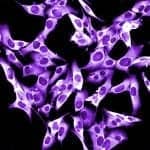
The study appears in Cell Death and Differentiation.
Researchers led by Mikhail Nikiforov, PhD, of Roswell Park Cancer Institute (RPCI) in Buffalo, NY, investigated the role of GMPS, a key enzyme in guanylate metabolism, in melanoma development and metastasis.
Guanylates, as the precursors to one of the four bases that make up RNA, play a critical role in cells. The authors evaluated the effects of GMPS depletion and explored the possibility of targeting GMPS by angustmycin A, also known as decoyinine. While this compound was discovered in the early 1950s as a potential antibiotic, it has never been experimentally investigated as an antitumor agent nor investigated at all in clinical settings.
They found that GMPS levels are increased in human metastatic melanoma specimens and that pharmaceutical inhibition of GMPS by angustmycin A may be effective as a targeted anti-melanoma therapy for tumors carrying either of the two most common mutations: BRAFV600E and NRASQ61R.
“These are early, preclinical findings, but they open up the exciting prospect of possibly treating melanoma with an inexpensive and well-tolerated agent,” says Nikiforov, a professor of oncology in the Department of Cell Stress Biology at Roswell Park, in a news release. “And because we have previously shown that guanylate pools can influence the invasion of cell lines derived from other types of cancer as well, we are also excited about the possibility of uncovering widespread mechanisms and targets that can be common to other kinds of tumors.”
Now the team has started further laboratory studies to investigate the antimelanoma efficacy of angustmycin A, both as a stand-alone therapy and in combination with conventional therapy.


